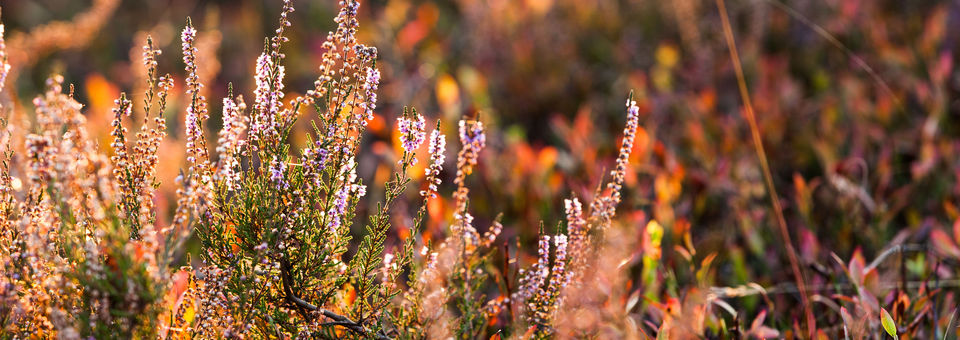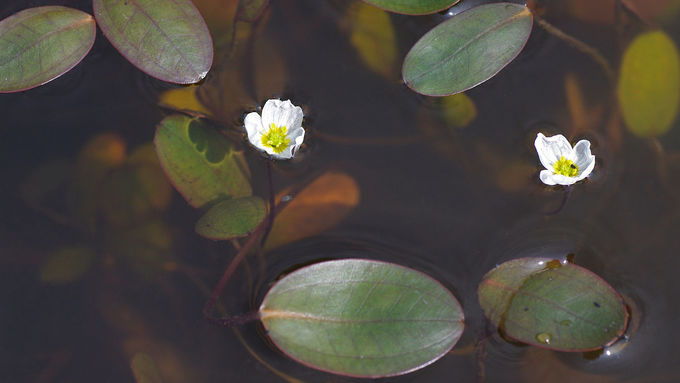Froschkraut/Floating Water-Plantain (Luronium natans) © Christian Fischer/CC BY-SA 3.0
download picturemain content
Protected Species
LURONIUM NATANS (1831)
Floating Water-Plantain
The Floating Water-Plantain is an aquatic plant which has become rare in Central Europe. Its preferred habitat are shores of shallow, nutrient-poor still waters, which are little overgrown and preferred habitat of frogs as well. The Floating Water-Plantain occurs in three different forms: as a pure submerged plant in rosettes on the bottom of deeper waters, as a floating leaf plant in shallow waters and as a rooted plant in dried-up waters or river banks. A reliable identifying characteristic compared to other aquatic plants are the leafy stem and the solitary flowers.
Habitat and biology
The Floating Water-Plantain has an Atlantic distribution. The plant appears predominantly in initial stages or pioneering plant societies. It is used as a class indicator species of shoreweed associations (Littorelletea), but can also be found in pondweed associations (Potamogetonetea). It mainly settles in sporadically flat flooded shores of oligotrophic to mesotrophic lakes with little alkaline heath ponds and pools as well as shores of streams (in particular ditches) with moderately rapid flowing water in a preferably 20 to 60 centimetres deep the riparian zone. Substrates can be sand, gravel and clay as well as mud. One distribution focus is in waters belonging to the habitat types 3110 and 3130.
The main development time and bloom is in the period from May to September or October. The seeds seem to remain germinable a long time in the soil so that the species may reoccur after management and development actions at sites where it is believed to be extinct. Propagation and dispersion may be via tillers, vegetative overwintering organs or seeds.
Occurence
The Floating Water-Plantain is classified as „Endangered“ (EN) in North Rhine-Westphalia. The known distribution areas all lie in the Atlantic region of the federal state, with a core area in the Westphalian basin.
In Lower Saxony, the species is also listed as “Endangered” (EN) in the Red List. Its southeastern distribution border touches Osnabrück, coming from the southwest, bends at Hannover to the east and continues further to the east to the Drömling. A reference given south of this line near Walkenried in the southern Harz has been considered extinct for some time. It is striking that the species has a main area of distribution in the west of Lower Saxony and the sightings east of the Weser are, in contrast, extremely rare. The vast majority of sites with the Floating Water-Plantain in Germany lie within Lower Saxony, and here especially in its western part. This results in a very high responsibility for the preservation of the populations.
Threats
The Floating Water-Plantain is threatened in particular by water eutrophication and water pollution of any kind, drainage and backfilling of waters, succession because of abandoned water body management and by intensive forms of use. Even populations with a good conservation status are threatened by damaging impacts such as water filling, direct action of herbicides and fertilizers effects, liming or transformation of waterbodies. The number of growth sites and partly also the type of habitat (e.g. ditches in utilized grassland) make it difficult to keep a permanent overview of the population and the conservation status of the Floating Water-Plantain. Particularly outside the flora-fauna-habitat areas, nature reserves and waters of the small waterbodies programme, deterioration and destruction of an accidental nature is possible due to the inconspicuousness of the species.
Types of action
Basic actions for the protection of the Floating Water-Plantain include the prevention of nutrient input by creating a buffer zone, the clearing of woody plants in the case of increasing shading of the banks, occasional and careful desludging of waters or careful clearance of ditches (including embankment mowing and removal of the cut vegetation), the restoration of previous sites through repeated extraction of silted water as well as the prevention of water use through fish stocking, liming or feeding of game.
Actions within phase 1 of the LIFE IP
In the first phase of the project, three actions which focus on improving the conservation status of the Floating Water-Plantain will be implemented in North Rhine-Westphalia. These include, in particular, improvement actions for typical habitats (habitat type 3130): optimization of existing waters (for example by desludging, shallowing the banks or clearing bank areas), expanding existing waters and restoring heath ponds.
In Lower Saxony, four actions will be implemented in the first project phase. These include the (initial) restoration of the habitat by removing seedlings from the wooded banks, the extension of existing waters, the expansion of a ditch which is suitable for growth to stabilize the population, and the creation of new ponds and translocation. In one case, the acquisition of grassland areas is intended to create buffer strips and shallow water zones around the waterbody to increase the population.
Related Topics
additional information
Further Links
- Species profile „Floating Water-Plantain“ – State Agency for Nature, Environment and Consumer Protection (LANUV NRW) (in German) (external link opens in a new window)
- Implementation notes for the protection of the Floating Water-Plantain – Lower Saxony Water Management, Coastal Defence and Nature Conservation Agency (NLWKN) (in German) (external link opens in a new window)
- Species Profile „Floating Water-Plantain“ – German Federal Agency for Nature Conservation (BfN) (in German) (external link opens in a new window)
- German Prioritised Action Frameworks (PAF): Floating Water-Plantain, page 104 – German Federal Agency for Nature Conservation (BfN) (in German) (external link opens in a new window)




